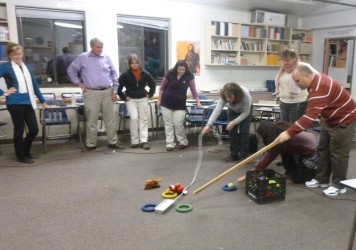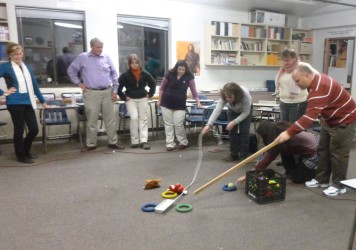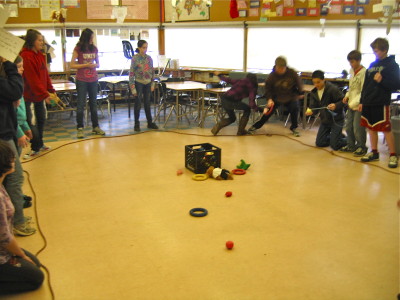
Jan 13, 2013 A Favorite Collaborative Problem Solving Challenge: Fill the Crate
A few weeks ago I posted a picture on Facebook of a group of teachers engaged in one of my favorite problem-solving activities. I received a number of queries asking more about this activity. Here is the description:

This is one of my favorite problem solving challenges because there are many solutions unique to each group that takes it on. I find this activity tells me a lot about a group’s dynamics and working style and offers great “food for thought” for group members to reflect on their roles, communication and collaboration methods.
Skills/Focus Areas:
Collaboration, Creative Problem Solving, Using Resources, Innovation, Planning, Experimentation, Persistence
Equipment:
• Milk crate full of soft objects of various shapes, sizes and weight
• Large perimeter rope
• 2nd perimeter rope for a planning Circle
Facilitation Suggestions:
• Create a large perimeter circle on the ground
• Empty the crate of objects outside the perimeter
• Place the empty crate back in the middle of the circle
• Challenge the group to get the balls/objects back into the crate without stepping into the circle, or moving the rope
• With some groups I add “no talking” to the parameters (experiment with the no talking rule, younger age groups will likely have a hard time not talking-and you likely want them to practice dialogue around planning and problem solving. A good option is to create another circle away from the problem where the group is encouraged to plan together).

Outcomes/Reflection Ideas:
This game can lead to a great discussion around planning ahead, communication, dealing with frustrations, leadership and looking at a problem from different perspectives.
This activity naturally leads to reflection on creative thinking, collaboration and innovation. I often use my “treasure chest”, “Miniature Metaphors” or computer key board keys and ask group members to each pick an object or key that represents the role they took on during the activity. This usually leads to metaphorically rich discussion about their group dynamics, roles, approaches to group-decision making and planning.
Reference:
This activity was inspired more than 15 years ago by a similar challenge presented by Jim Schoel at an Islands of Healing workshop. It has changed over the years with the co-creative experiences of the groups who have experimented with it. There is additional information and examples of group outcomes in Tips & Tools for the Art of Experiential Group Facilitation. Stanchfield, 2007.



No Comments